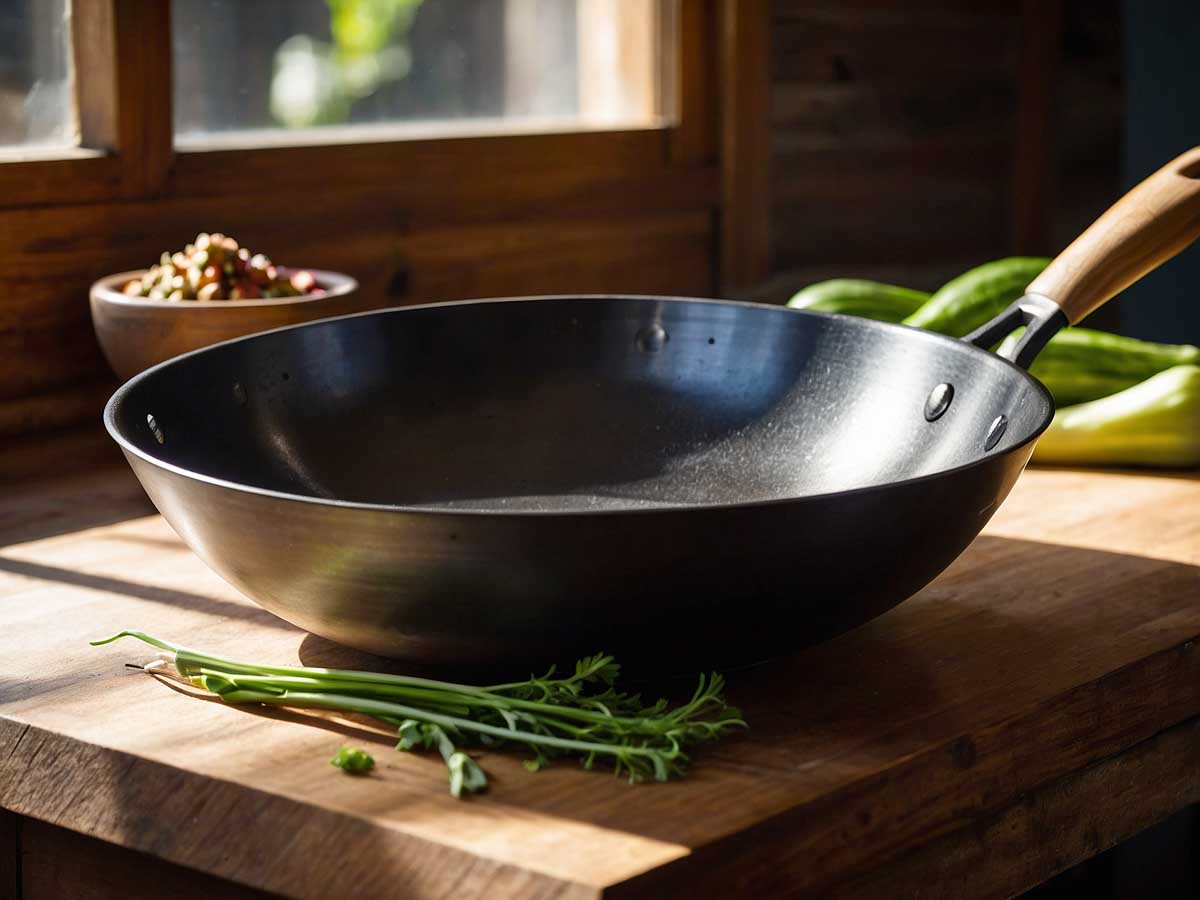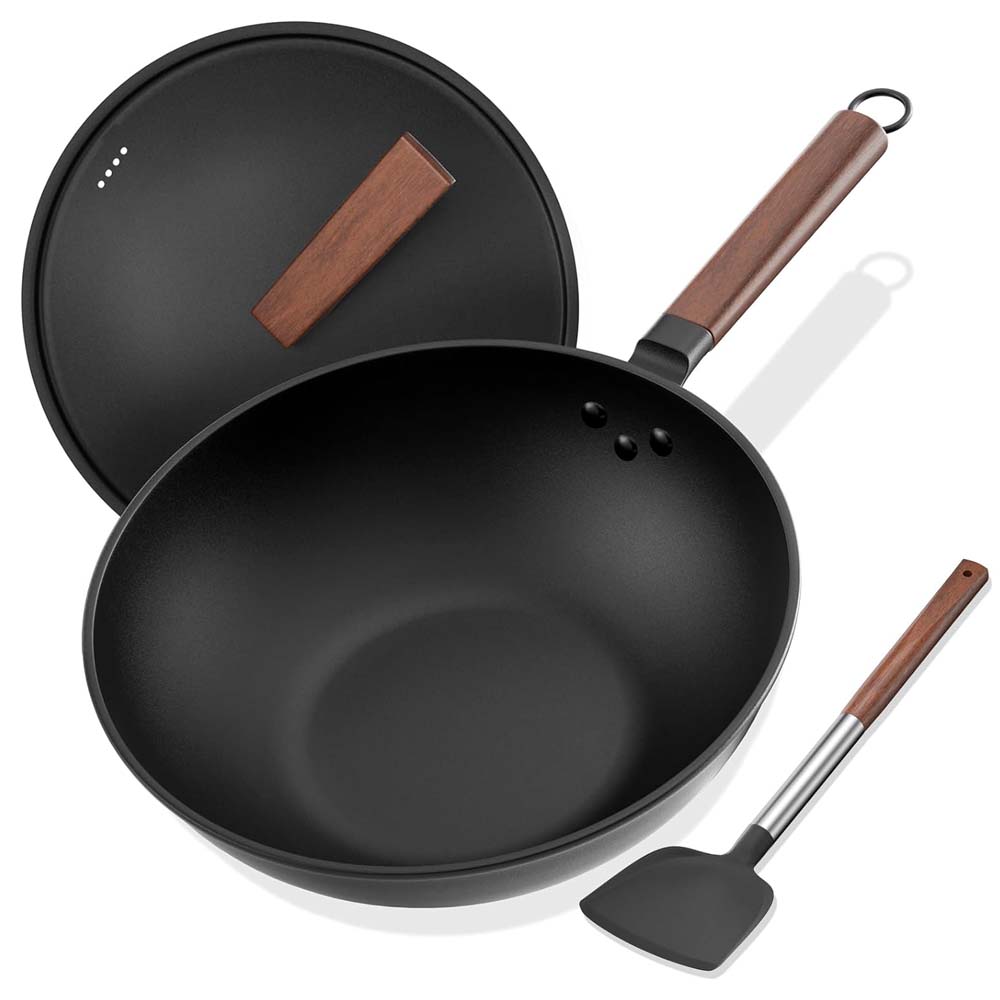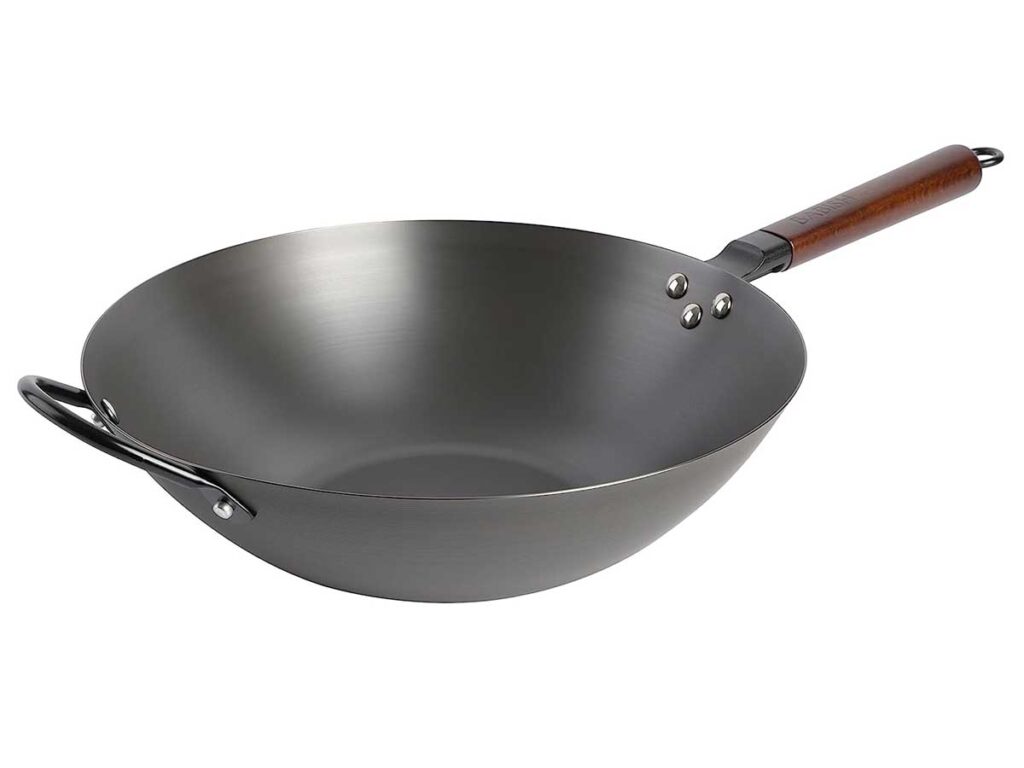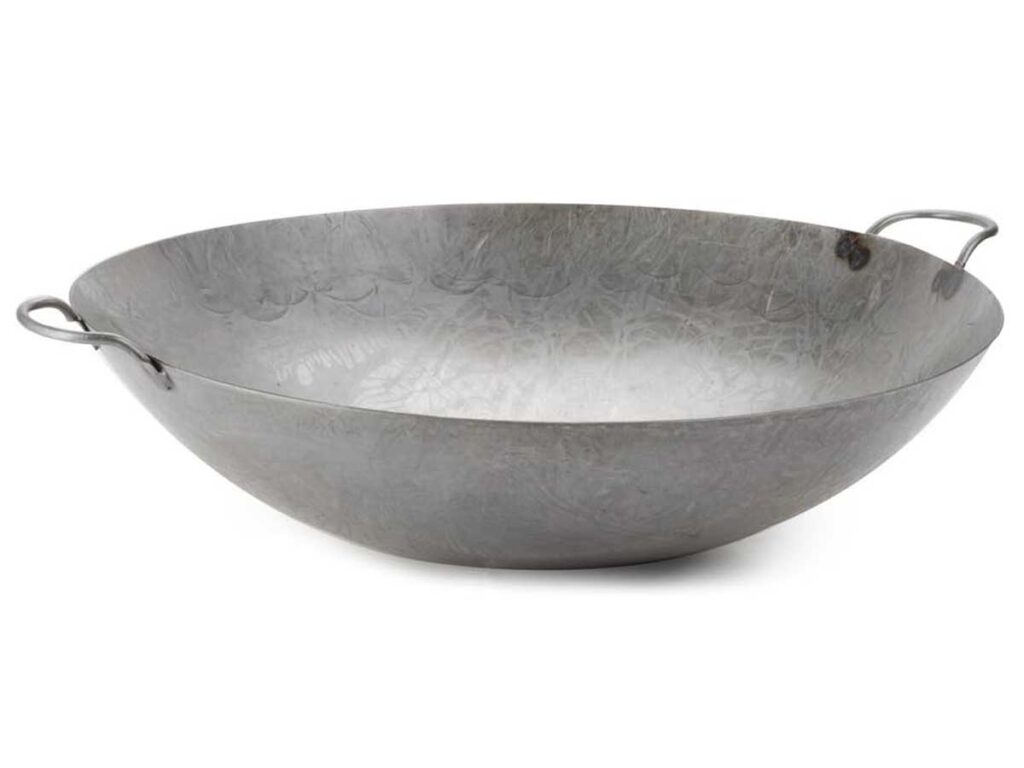What is Carbon Steel Wok? Everything You Need to Know

A carbon steel wok is a versatile and durable cooking pan known for its quick heating and lightweight design, ideal for various cooking techniques like stir-frying and steaming. A carbon steel wok is popular due to its quick heating, lightweight design, and versatility; it originated in China and has been a staple in Asian cooking for centuries.
Its versatility makes it suitable for a variety of cooking methods, from stir-frying to deep-frying and steaming. Whether you’re making a quick stir-fry or preparing a more complex dish, a carbon steel wok can handle it all. The unique attributes of this durable wok make it a valuable addition to any kitchen.
Why Choose a Carbon Steel Wok?
The benefits of carbon steel woks are numerous, making them a preferred choice for many cooks. One of the primary advantages is their ability to heat up quickly and evenly. This ensures that your food cooks uniformly, which is especially important for stir-frying where high heat and fast cooking times are essential.

Another significant benefit is the lightweight nature of carbon steel woks. Unlike cast iron woks, which can be quite heavy and cumbersome, carbon steel woks are easier to handle and maneuver. This is particularly useful when you need to toss ingredients frequently.
Affordability is another key factor. Compared to other materials like stainless steel, carbon steel woks are generally more budget-friendly, making them accessible to a wider range of people. Despite their lower cost, they do not compromise on performance or durability.
When you compare carbon steel and cast iron, you’ll find that carbon steel is less prone to rusting and easier to maintain. However, like cast iron, carbon steel woks do require seasoning. Seasoning a carbon steel wok involves applying a thin layer of oil and heating it to create a natural, non-stick coating. This process not only enhances the non-stick properties but also adds to the wok’s overall longevity.
Types of Carbon Steel Woks
When it comes to carbon steel woks, there are several types to consider, each with its own specific uses and features. The main types are flat-bottom woks and round-bottom woks, as well as northern-style woks and Cantonese-style woks.
Flat-Bottom Wok

A flat-bottom wok is designed to sit directly on modern stovetops, including electric and induction ranges. This type of wok is convenient for those who do not have access to a traditional wok burner. The flat bottom allows for even heat distribution and stability on flat surfaces, making it versatile for a variety of cooking methods. It’s particularly suitable for home kitchens with standard stovetops.
Round-Bottom Wok

The round-bottom wok is the traditional design, preferred for its optimal heat distribution. This type of wok is ideal for gas stoves or specialized wok burners. The round bottom allows for food to be easily tossed and stirred, making it perfect for stir-frying. However, it typically requires a wok ring to keep it stable on flat stovetops, which can be an added consideration for home cooks.
Northern-Style Wok

A northern-style wok typically features a single long handle, similar to a frying pan. This handle style makes it easy to lift, toss, and maneuver the wok, which is particularly useful for quick stir-frying techniques. Northern-style woks are usually lighter and more convenient for cooks who need to frequently lift and shake the wok.
Cantonese-Style Wok

In contrast, a Cantonese-style wok has two small loop handles on either side. This design is beneficial when you need to handle the wok with both hands, especially when it’s full of food or when you’re moving it from the stovetop to the table. This style is more traditional and is often used for larger, family-style dishes.
Each type of wok has its own advantages, and the choice depends largely on your cooking style and the type of stove you have. Both flat-bottom woks and round-bottom woks offer great versatility, while the handle style of northern-style woks and Cantonese-style woks caters to different preferences in handling and cooking.
How to Season a Carbon Steel Wok
Seasoning your carbon steel wok is crucial for creating a natural non-stick surface and enhancing its longevity. Here’s a detailed step-by-step guide on how to season a wok:
- Clean the Wok: Start by washing your new wok with warm water and a mild detergent. Use a sponge or soft brush to remove any factory oil or residue. Rinse thoroughly and dry completely with a clean towel.
- Heat the Wok: Place the wok on your stovetop over medium-high heat. Let it heat up until it starts to change color, usually to a bluish hue. This helps remove any remaining moisture and prepares the surface for seasoning.
- Apply Oil: Once the wok is hot, add a small amount of high-smoke point oil, such as vegetable oil or flaxseed oil. Use a paper towel to spread the oil evenly across the entire surface of the wok, including the sides. Be careful not to burn yourself, as the wok will be very hot.
- Heat Again: Continue heating the oiled wok over medium-high heat. The oil will begin to polymerize, forming a non-stick layer. You’ll notice smoke rising from the wok, which is normal. Let it smoke for about 10-15 minutes, then remove from heat and let it cool slightly.
- Repeat: For best results, repeat the oiling and heating process 2-3 times. Each layer of oil will build up the non-stick surface, making your wok more effective for cooking.
- Final Wipe: After the final heating, let the wok cool down completely. Wipe it with a clean, dry paper towel to remove any excess oil. Your wok should now have a smooth, non-stick surface ready for cooking.
Maintenance Tips
- Regular Use: The more you use your seasoned wok, the better the seasoning will become. Cooking with oils and fats will continue to enhance the non-stick layer.
- Cleaning: After each use, clean your wok with warm water and a soft sponge. Avoid using soap or abrasive materials that can strip away the seasoning. Dry it thoroughly after washing.
- Re-Seasoning: If food starts to stick or the wok loses its non-stick properties, simply repeat the seasoning process to restore the surface.
By following these steps, you’ll ensure that your seasoned carbon steel wok remains a reliable and non-stick wok for many years. This process not only improves cooking performance but also extends the life of your wok, making it a valuable tool in any kitchen.
Check out the Wok Cooking 101, if you have more query about wok pan.
Cooking Techniques with a Carbon Steel Wok
A carbon steel wok is incredibly versatile and can handle a variety of cooking techniques. Here are some of the main methods:
Stir-Frying
Stir-frying is perhaps the most common technique associated with a wok. The high heat and quick cooking time make it ideal for cooking vegetables, meats, and seafood. The sloped sides of the wok allow you to push cooked ingredients up the sides while you continue cooking in the center. This ensures everything is evenly cooked and maintains a crispy texture.
Deep-Frying
Deep-frying with a carbon steel wok is efficient because the wok’s shape requires less oil than a traditional deep fryer. The wide opening allows you to monitor and manage the frying process easily. The even heat distribution ensures that your food is cooked uniformly, resulting in crispy and delicious fried dishes.
Steaming with a Wok
Steaming with a wok is simple and effective. You can use a bamboo steamer or a metal rack inside the wok. The curved sides hold the steamer or rack in place, while the wok’s depth provides ample space for water. This method is great for cooking dumplings, fish, and vegetables, preserving their nutrients and flavors.
Smoking with a Wok
Smoking with a wok is another technique that takes advantage of the wok’s unique shape. You can create a smoker by placing a rack inside the wok and covering it with a lid or foil. This method allows you to infuse foods with a rich, smoky flavor. The carbon steel material handles high heat well, making it suitable for this method.
These techniques showcase the versatility of a carbon steel wok, making it an essential tool for various cooking styles. Whether you’re stir-frying, deep-frying, steaming, or smoking, the wok’s properties enhance the cooking process, delivering delicious results.
Check out my wok pan recipes if you love to cook over a wok.
Maintenance and Care
Proper maintenance and care are crucial for ensuring your carbon steel wok stays in good condition and performs well. Here are some tips:
Cleaning a Carbon Steel Wok
- After Each Use: Clean your wok with warm water and a soft sponge. Avoid using soap, as it can strip away the seasoning. If there are stubborn food residues, use a gentle scrubber or a bamboo brush.
- Dry Immediately: After washing, dry the wok thoroughly with a clean towel to prevent rust.
Maintaining Wok Seasoning
- Regular Oil Application: After cleaning, apply a thin layer of high-smoke point oil to the inside of the wok. This helps maintain the non-stick surface and prevents rust.
- Heat Treatment: Occasionally, heat the wok over medium heat with a small amount of oil. This helps reinforce the seasoning and keeps the surface smooth.
Rust Prevention
- Proper Storage: Store your wok in a dry place. Avoid stacking other cookware on top of it to prevent scratches and damage to the seasoning.
- Inspect Regularly: Check your wok for any signs of rust. If you spot any, scrub it off gently with a steel wool pad and re-season the affected area.
By following these tips, you’ll keep your carbon steel wok in excellent condition, ensuring it remains a reliable and efficient cooking tool.
Frequently Asked Questions
Last Few Words
In summary, a carbon steel wok is a fantastic addition to any kitchen. Its key benefits include quick, even heating, and a lightweight design, making it easy to handle.
The wok’s affordability and ability to develop a natural non-stick surface with seasoning add to its appeal.
With various types like flat-bottom and round-bottom, it’s a versatile cooking tool suitable for many techniques.
Whether you’re stir-frying, deep-frying, steaming, or smoking, a carbon steel wok enhances the cooking process.
Give a carbon steel wok a try and experience these benefits in your kitchen. Stay connected with Kit Yum for more knowledge base guides.
